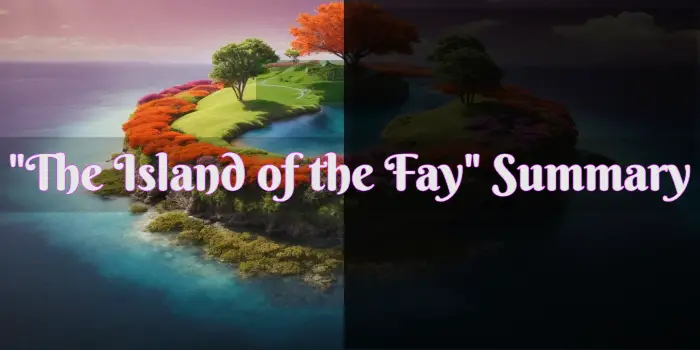“The Island of the Fay” is a short story by Edgar Allan Poe about a meditative man with fanciful notions who has a surreal experience deep in nature. This isn’t one of Poe’s better known stories. It’s light on action and is a bit hard to follow. Here’s a plot summary of “The Island of the Fay”.
“The Island of the Fay” Summary
The narrator believes music can only be fully enjoyed when we are fully alone. The only pleasure that benefits more than music from solitude is contemplating nature. Any accompanying form of life, other than greenery, takes away from the experience.
He regards the natural features of Earth, as well as the planets, moon and sun, as a sentient whole that’s perfect and inclusive. It’s no more aware of us than we are of the microscopic organisms in our brain.
Science has established that space and the stars in it are immense, so size must be an important consideration for the Almighty. This infinite space could be matched by an infinity of matter. We may suppose that the universe with all its matter has vitality—cycles within cycles and life within life, from the microscopic to the enormous. It’s human arrogance to believe we are more important than the rest of the universe.
This philosophy of the narrator lends to his meditations a fantastical bent. He has often wandered alone in nature; the solitude intensifies the experience. During one of these trips, deep in the mountains among the tarn and rivers, he comes upon a small stream and island.

The sun is setting in the west; on all other sides is forest. One end of the river quickly turns out of sight. On the other, a gold and red waterfall appears to fall from the sky. He lies down under a shrub to rest for a while.
Midway through his dreamy slumber, he sees a small, round, lush island on river bank. The mirror effect of the water makes both look like they’re floating.
The western side of the islet is filled with colorful flowers and graceful trees. Numerous butterflies create a feeling of motion. The eastern side is covered in a dark shade, giving it a somber yet peaceful gloom. The trees look mournful and the grass seems to droop their heads. The many hillocks give the appearance of graves. The water is heavily shaded by the trees.
He imagines the island to be enchanted—the haunt of the few remaining Fays. As the sun sets, he muses on the Fay’s graves and how they die. Among the swirling white sycamore flakes, he sees a Fay move from the light side of the island into the dark side, with her expression changing from joyful to sorrowful. She rounds the island and reappears on the light side. The narrator compares the revolution to a year in her life cycle. Her shadow seemed to fall away in the shade and add to its darkness.
The Fay continues making this circuit of the island, each time adding a layer of blackness to the dark side and reemerging more sorrowful and dimmer on the light side. When the sun goes down, the Fay is a ghost of its former self. It moves into the dark side. The narrator doesn’t see her magical figure again, as the darkness swallows everything.
I hope this summary of “The Island of the Fay” by Edgar Allan Poe was helpful.
